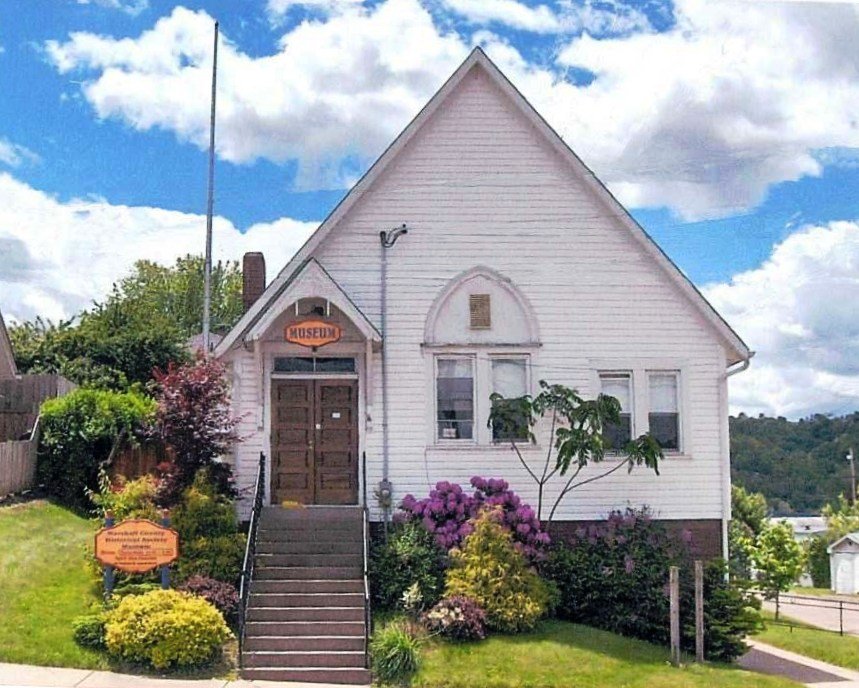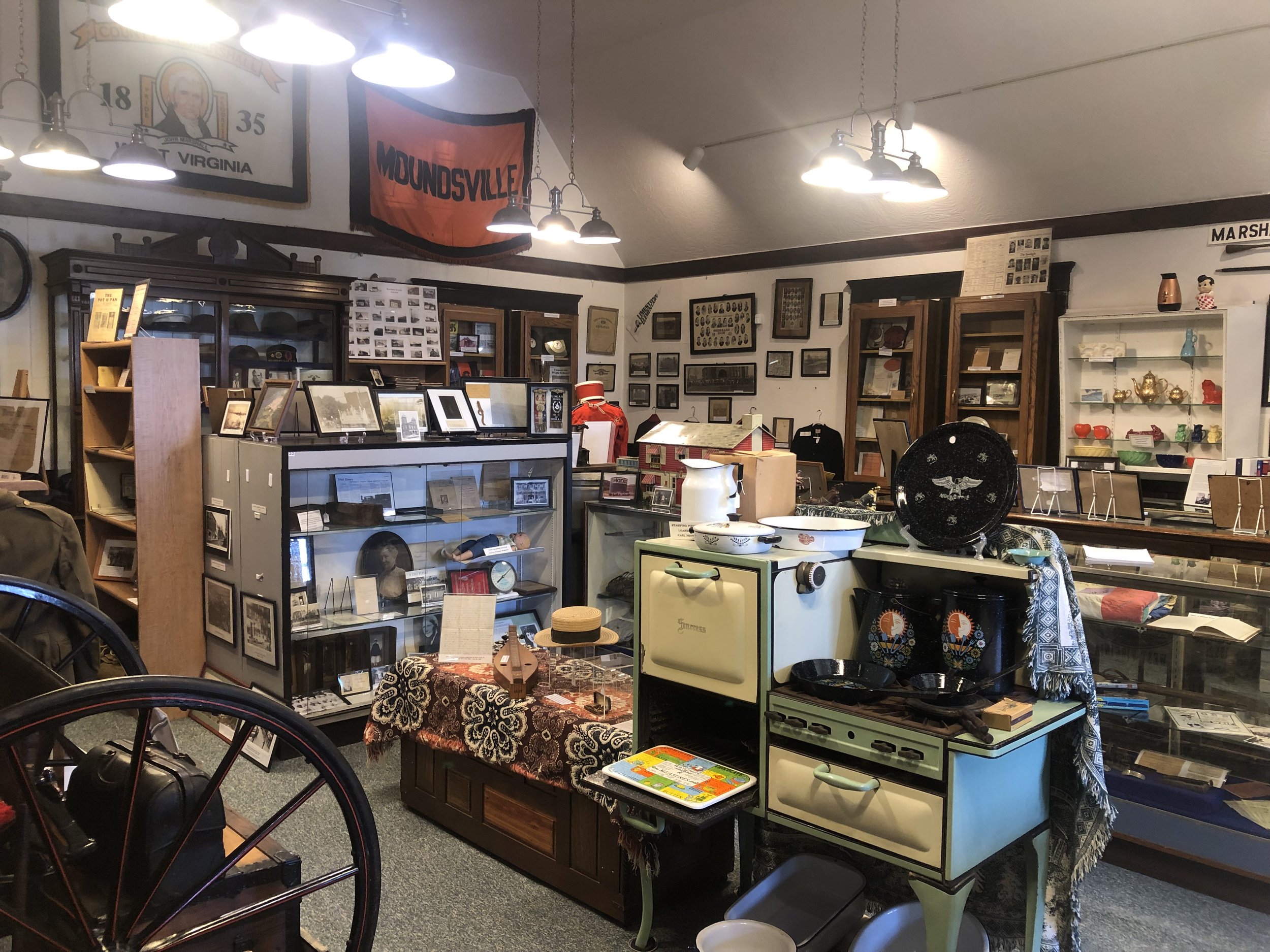
Information
What we do
The M.C.H.S. is dedicated to preserving this history as well as educating others on the county's rich history. We collect, preserve, and promote artifacts that reflect our county's legacy in order to educate the many generations that will come after us about their past.
We operate two museums, the Marshall County History Museum located at the corner of 13th and Lockwood in Moundsville and the Cockayne Farmstead across the street from John Marshall High School in Glen Dale. These two museums each provide a unique glimpse into the past of Marshall County. The Marshall County History Museum's collection of artifacts and genealogy files has been decades in the making. The Cockayne Farmstead focuses on life in the Victorian Era. The original 1890s interior teleports you back through time as you follow the story of the Cockayne Family, one of Marshall County's earliest families.
Throughout the year, we hold several Society and Cockayne events, including open houses, guest speakers, and living history to bring you back through time.
After separating from Ohio County in 1835, Marshall County has been where business thrives, families grew, and history was made.
Thousands of years before settlers arrived in what would become Marshall County, the area was inhabited by the Native Adena people. The Adena are very well known for their magnificent burial mounds that are dotted around the states of Ohio, Kentucky, Indiana, West Virginia, and western Pennsylvania. Marshall County is home to the largest Adena burial mound, the Grave Creek Mound located in Moundsville.
Our Home
Grave Creek Mound, Moundsville
Joseph, James, and Samuel Tomlinson were the first settlers to come to what would eventually become Moundsville. Joseph, a Revolutionary War Captain of the Guard, was the first European settler to discover the Grave Creek Mound while out hunting.
Some other early settlers include:
John Wetzel who built a cabin what is now the Sand Hill district in 1769
Mr. Cresap who settled in what is now the Franklin district
John, James, and David Bonar on what would become known as Bonar’s Ridge
Peter Yoho on Fish Creek
Richard Campbell and Thomas Buchanon in the Sand Hill district
Johnathan Purdy on Grave Creek
Eventually, Joseph Tomlinson planned and established the town of Elizabethtown, named after his wife. In 1866, Elizabethtown and the nearby town laid out by Simeon Purdy named Moundsville were consolidated under the name Moundsville.
Joseph Tomlinson House, burned and rebuilt, eventually torn down to make way for Moundsville High School. There is now a stone marker at the location.
Bennett Cockayne House in 1877.
Valley Farm, Glen Dale - Built 1798
In 1866, the newly formed state of West Virginia needed to build a state Penitentiary. Due to its proximity to Wheeling, the Capital WV at the time, Moundsville was chosen to be the home of the state’s only maximum security penitentiary. The West Virginia State Penitentiary became known as one of the most violent prisons in the nation, earning the nickname “Blood Alley”. Over 900 deaths took place here from the 1920s to its’ closure in 1995, which does not include the 94 executions, 85 by hanging and 9 by electric chair.
West Virginia Penitentiary, 1876
Through much of the 19th century, the county’s economy was mostly focused around agriculture, but by the early 20th century, industry had exploded.
In 1892, the Fostoria Glass Company, a very popular glass manufacturer, moved their operations to Moundsville. United States Stamping, producers of enameled cookware, began their operations here in 1901. Soon the county became a producer of various goods including: brooms, whips, pottery, clothing, and metal goods.
In the 1920s, the Fokker Aircraft Corporation came to Glen Dale. Paired with the arrival of a few other factories, available jobs in the area exploded. In 1934, The Louis Marx Toy Company created the largest toy plant in the world in the former Fokker plant.
McMechen in the 1900s
Today, after the decline of industry, Marshall County is home to some amazing tourist attractions, including the Delf Norona Museum at Grave Creek Mound, the Former West Virginia Penitentiary, the Palace of Gold (also known as New Vrindaban, a Hare Krishna temple built in the 1970s), the Fostoria Glass Museum, the Cockayne Farmstead, and Grand Vue Park. Each allows you to appreciate different eras of Marshall County’s History, from prehistoric times to days within living memory.
Moundsville in the 1940s
Moundsville High School, built on the Tomlinsons’ house site
County Infirmary, 1938
Center McMechen School
Presbyterian Church, Limestone
Simpson Church, 1961
The Strand Theater, 1920s-30s
Glen Dale Post Office, 1930s
Moundsville Post Office
Prisoner Intake at the Penitentiary
3rd and Jefferson, Moundsville, 1945
Help us preserve
your history!
Your donation will help us carry on the legacy of Marshall County and ensure we are able to function!
Donate
Want to keep up with the happenings of the society? Become a member today and get great benefits!
Join
Volunteer
Want a more hands-on way of helping us preserve history? We always have something for you to do!
Our Board of Directors
Board of Directors:
Dan Butler
Nan Hartley
David Robbins
Tanner Skym
President: Gary Rider
Secretary: Andrea Keller
Treasurer: Bonnie Mueller


















